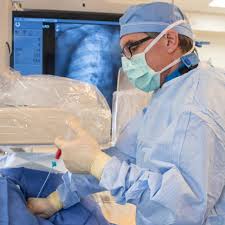Interventional Imagers Exposed to Markedly Higher Radiation Levels During Heart Procedures
 According to an article on TCTMD and as reported in a study published in JAMA Open Network, interventional imagers are exposed to markedly higher levels of radiation during structural heart procedures. The higher levels range from threefold higher for left atrial appendage occlusion (LAAO) procedures to 12-fold higher for transcatheter edge-to-edge repair (TEER) of mitral valve disease, according to the investigators.
According to an article on TCTMD and as reported in a study published in JAMA Open Network, interventional imagers are exposed to markedly higher levels of radiation during structural heart procedures. The higher levels range from threefold higher for left atrial appendage occlusion (LAAO) procedures to 12-fold higher for transcatheter edge-to-edge repair (TEER) of mitral valve disease, according to the investigators.
Lead author David A. McNamara, MD (Spectrum Health, Grand Rapids, MI), told TCTMD, ““We did hypothesize that interventional echocardiographers were going to have higher radiation doses,” because of their positioning closer to the source of radiation. He added, “However, the degree to which we saw this was greater than we expected.”
Radiation data from interventional echocardiographers, interventional cardiologists, and sonographers was collected by Dr McNamara and colleagues from their institution who performed 30 sequential LAAO and 30 sequential TEER procedures between July 2016 and January 2018. Mean age was 79 years, 53.3% of patients were male, and all were considered to be at high cardiovascular risk. Median fluoroscopy time was longer for TEER than for LAAO procedures (20.9 vs 9.2 minutes; P < 0.001).
Interventional echocardiographers were exposed to an overall higher median radiation dose per case than interventional cardiologists (10.6 vs 2.1 μSv). This finding was maintained when looking individually at TEER (10.5 vs 0.9 μSv) and LAAO (10.6 vs 3.5 μSv; P < 0.001 for all). Sonographers reported lower median radiation doses than interventional imagers during both LAAO (0.2 μSv) and TEER procedures (0.0 μSv; P < 0.001 for both).